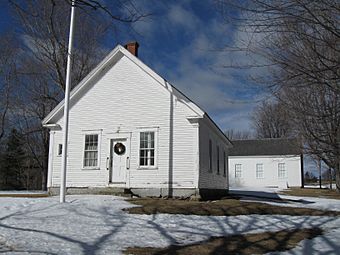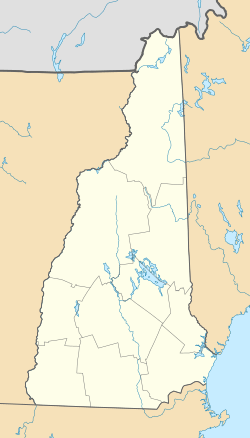Smith Meeting House facts for kids
Quick facts for kids |
|
|
Smith Meeting House
|
|
 |
|
| Location | Jct. of Meeting House and Governor Rds., Gilmanton, New Hampshire |
|---|---|
| Area | less than one acre |
| Built | c. 1840 |
| Architectural style | Greek Revival |
| NRHP reference No. | 98000196 |
| Added to NRHP | March 23, 1998 |
The Smith Meeting House is an old and important church building. It is located where Meeting House Road and Governor Road meet in Gilmanton, New Hampshire. This building was constructed around 1840. It is a great example of a church from the 1800s that has been kept in good condition. Because of its historical value, it was added to the National Register of Historic Places in 1998.
Contents
About the Smith Meeting House
The Smith Meeting House stands in a quiet, countryside area. It is close to the center of Gilmanton. You can find it just south of where Meeting House Road and Governor Road cross.
Building Design and Features
This building is made of wood and has one and a half stories. It has a pointed roof and its outside walls are covered with wooden boards called clapboards. The foundation is made of strong granite stone.
The front of the building has two doors placed evenly. Above these doors are three windows. The window in the middle is a beautiful stained glass window. It shows a design of flowers, a cross, and a crown.
Inside, at the back, there are two small entry areas. One of these areas has a narrow staircase. This staircase leads up to a special balcony where a choir would sing. The main room of the church is quite simple. It has pine wood floors and wooden panels on the lower part of the walls. Today, electric lights brighten the room. However, the original lamps that used kerosene and fancy hanging lights are still there.
A Look Back at Its History
The church was built around 1840. It was named after Isaac Smith, who was Gilmanton's very first minister. He used to preach at the town's first meeting house, which was also located on this same spot. People say that some of the wooden parts used to build the original meeting house were also used in the current building.
Over time, the church was not used as much for town events. Its use for religious services also became less frequent in the late 1800s. In 1898, a group called the Old Smith Meeting House Improvement Society took over its care. They have helped keep this historic building in good shape for many years.
More to Explore



